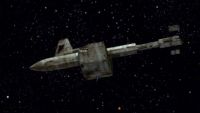Difference between revisions of "1990s (FASA)"
From Trekipedia
m |
m |
||
| Line 1: | Line 1: | ||
{|style="width:100%;" | {|style="width:100%;" | ||
| − | | | + | |style="width:33%;" class="HeaderRow"|Prev: [[FASA Chronology: 1980s|1980s]] |
| − | | | + | |style="width:34%;text-align:center;" class="HeaderRow"|[[FASA Chronology]] |
| − | | | + | |style="width:33%;text-align:right;" class="HeaderRow"|Next: [[FASA Chronology: 2000s|2000s]] |
|} | |} | ||
| Line 41: | Line 41: | ||
{|style="width:100%;" | {|style="width:100%;" | ||
| − | | | + | |style="width:33%;" class="HeaderRow"|Prev: [[FASA Chronology: 1980s|1980s]] |
| − | | | + | |style="width:34%;text-align:center;" class="HeaderRow"|[[FASA Chronology]] |
| − | | | + | |style="width:33%;text-align:right;" class="HeaderRow"|Next: [[FASA Chronology: 2000s|2000s]] |
|} | |} | ||
{|style="width:100%;" | {|style="width:100%;" | ||
| − | |+class="HeaderRow"| | + | |+class="HeaderRow"|References |
|- | |- | ||
|<references> | |<references> | ||
Revision as of 13:26, 17 January 2019
| Prev: 1980s | FASA Chronology | Next: 2000s |
Reference Stardates -1/9000 through -1/9900
1990
- RSD -1/9000: An asteroid probe is launched, which will remain in service until 1993.[1]
- c.RSD -1/9000: Kahless epetai-Riskadh becomes the first sole Emperor of the Klingon Empire, and he spearheads Klingon expansion efforts via warp drive.[2]
1991
- RSD -1/9000: The Saturn Dual Probe arrives at the planet, with the satellite going into orbit as the descent stage relays information as it enters the planet's atmosphere.[1]
1992
- RSD -1/9200: The Space Shuttle completes its twelve-year series so successfully, humanity will forever be in space.[1]
- RSD -1/9206 - -1/9609 (June 1992 - September 1996): The outbreak of the Eugenics Wars limits manned space efforts for a time, as resources are turned to global war.[3]
1994
- RSD -1/9400: Manned missions to the moon begin again, with several nations taking part. Cooperating as never before, they have a goal of building a permanent moon base by the turn of the century.[1]
- RSD -1/9403 (March): The first reliable records of Klingon enslavement of other races show the natives of the planet Delta Khinah II believed that the Romulan Star Empire once held (or at least explored) this planet. Delta Khinah II may have been the site of the first Romulan/Klingon conflict.[2]
1995
- RSD -1/9500: The DY-100 is the first mass-produced spacecraft capable of short interplanetary travel (Earth-moon). In an uprated mode, it will be able to take humans to Mars. The class will remain in service until 2020.[1]
- RSD -1/9500: The DY-100 class S.S. Copernicus is launched, with a complement of 22 people.[1]
1996
- RSD -1/9609.22 (22 September): The Eugenics Wars end with the defeat of the "supermen." Khan Noonian Singh and several dozen of his followers manage to steal a DY-100 class vessel, which they name the S.S. Botany Bay, and escape in cryogenic freeze in hopes of colonizing another world; this fact is concealed from the general public.[4][1][3]
- RSD -1/9609 (September): The Andorian Empire is formed with the first colonization of another world by Andorian explorers.[5]
1997
- RSD -1/9704.18 (18 April): The first permanent base on the moon is established, jointly funded by the United States of America and Japan. This marks the rededication of humanity to space exploration as part of the rebuilding following the Eugenics Wars.[3]
1998
- RSD -1/9800: Goddard Moonbase, the first large-scale international space project, will provide accommodations for 70 in the fields of space research and industry.[1]
1999
- RSD -1/9900: The Asteroid Belt Lander reveals the asteroid belt to be rich in important raw materials for further space industrialization.[1] Large-scale asteroid opens up Sol's asteroid belt to colonization. Several more lunar stations are opened this year by various nations and several private corporations. Armstrong Center, remaining the largest, has become a small city of scientists, technicians, and support personnel, and already is beginning to cater to a growing tourist trade.[3]
| Prev: 1980s | FASA Chronology | Next: 2000s |
|
